

Queer Places:
Académie Colarossi, 10 Rue de la Grande Chaumière, 75006 Paris
9 Rue Saint-Romain, 75006 Paris
52 Rue du Colisée, 75008 Paris, France
Villa dell’Ombrellino, 11 Piazza di Bellosguardo, 50124 Florence, Italy
Costa S. Giorgio, 54, 50125 Firenze FI
5 Stanton St, New York, NY 10002
302 E 66th St, New York, NY 10065
Aspen Grove Cemetery
Aspen, Pitkin County, Colorado, USA
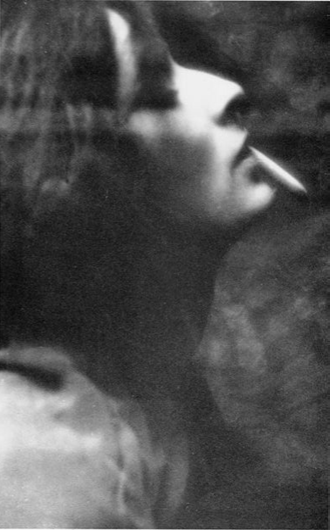 Mina
Loy (born Mina Gertrude Löwy; 27 December 1882 – 25 September 1966) was a
British-born artist, writer, poet, playwright, novelist, painter, designer
of lamps, and bohemian. She was one of the last of the first-generation
modernists to achieve posthumous recognition. Her poetry was admired by
T. S. Eliot,
Ezra Pound,
William Carlos Williams, Basil Bunting,
Gertrude
Stein, Francis
Picabia, and Yvor Winters, among others. As stated by
Nicholas Fox Weber in the New York Times, "This brave soul had the
courage and wit to be original. Mina Loy may never be more than a vaguely
familiar name, a passing satellite, but at least she sparkled from an
orbit of her own choosing." Djuna
Barnes wrote a lively bagatelle called Ladies Almanack in 1928.
Natalie Barney featured
here as Dame Evangeline Musset;
Romaine Brooks as Cynic Sal;
Lily de Gramont as
the Duchesse Clitoressa of Natescourt;
Una
Troubridge as Lady Buck-and-Balk;
Radclyffe Hall as Tilly
Tweed-in-blood; Mina Loy as Patience
Scalpel; Mimì Franchetti as Senorita
Fly-About; and Janet Flanner
and Solita Solano as Nip and
Tuck. The book was privately published by
Robert McAlmon.
Mina
Loy (born Mina Gertrude Löwy; 27 December 1882 – 25 September 1966) was a
British-born artist, writer, poet, playwright, novelist, painter, designer
of lamps, and bohemian. She was one of the last of the first-generation
modernists to achieve posthumous recognition. Her poetry was admired by
T. S. Eliot,
Ezra Pound,
William Carlos Williams, Basil Bunting,
Gertrude
Stein, Francis
Picabia, and Yvor Winters, among others. As stated by
Nicholas Fox Weber in the New York Times, "This brave soul had the
courage and wit to be original. Mina Loy may never be more than a vaguely
familiar name, a passing satellite, but at least she sparkled from an
orbit of her own choosing." Djuna
Barnes wrote a lively bagatelle called Ladies Almanack in 1928.
Natalie Barney featured
here as Dame Evangeline Musset;
Romaine Brooks as Cynic Sal;
Lily de Gramont as
the Duchesse Clitoressa of Natescourt;
Una
Troubridge as Lady Buck-and-Balk;
Radclyffe Hall as Tilly
Tweed-in-blood; Mina Loy as Patience
Scalpel; Mimì Franchetti as Senorita
Fly-About; and Janet Flanner
and Solita Solano as Nip and
Tuck. The book was privately published by
Robert McAlmon.
Loy was born in Hampstead, London.[1] She was the daughter of a Hungarian Jewish tailor, Sigmund Felix Lowry, who had moved to London to evade persistent antisemitism in Hungary, and an English Protestant mother, Julia Bryan.[2] Loy reflected on their relationship, and the production of her identity, in great deal in her mock-epic Anglo-Mongrels of the Rose (1923–1925). The marriage of Lowry and Bryan was fraught. Unknown to Loy, as biographer Carolyn Burke records, her mother married her father under the pressure of disgrace as she was already seven months pregnant with the child that would be Mina; this situation is mirrored later in Loy's life when she rushes into a marriage with Stephen Haweis due to being pregnant out of wedlock.[3] Lowry and Bryan had three daughters in total, with Mina being the oldest.[4]
As recorded extensively in both her poetry and writing, from Anglo-Mongrels of the Rose to late prose pieces, Loy describes her mother as overbearingly Evangelical Victorianism. As Burke records: "Like most Evangelicals, for whom the imagination was a source of sin, Julia distrusted her child's ability to invent."[5] In reference to her mother, Loy recalled that she was troubled by the fact that "the very author of my being, being author of my fear."[6] Loy found it hard to identify with her mother, who not only punished her continually for her "sinfulness," but also espoused fervent support of the British Empire, rampant antisemitism (which included her husband), and nationalistic jingoism.[7]
Loy's formal education began late in 1897 at St. John's Wood School where she remained for about two years. In retrospect, Loy called it "the worst art school in London" and "a haven of disappointment".[8] Loy's father pushed for her to go to the art school in the hope that it would make her more marriageable.[9] Around this time, Loy became fascinated with both Dante Gabriel Rossetti and Christina Rossetti, and after much convincing was able to persuade her father to purchase her Dante's Complete Works and reproductions of his paintings as well as a red Moroccan leather-bound version of Christina's poems.[10] She also became passionate about the Pre-Raphaelites, starting first with the work of William Morris before then turning to Edward Burne-Jones (her favourite work of which, at the time, was Love Among the Ruins).[11] Loy had to be careful as to how she expressed herself due to her mother's control. For example, Loy described that when her mother found a drawing she had done of the naked r bound to a rock her mother, scandalised and disgusted, tore up the work and called her daughter "a vicious slut".[12]
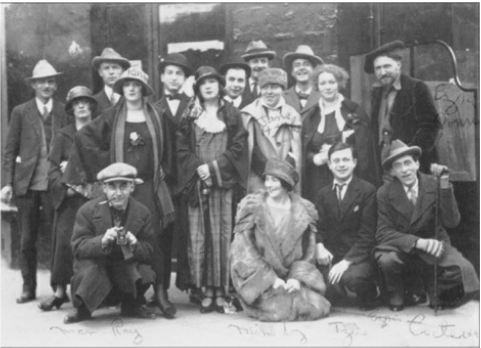
Margaret Anderson and Jane Heap, middle standing; Ezra Pound, right
standing; Man Ray, with camera; Mina Loy, front center; Tristan Tzara, to
her right; and Jean Cocteau, with cane; in Paris
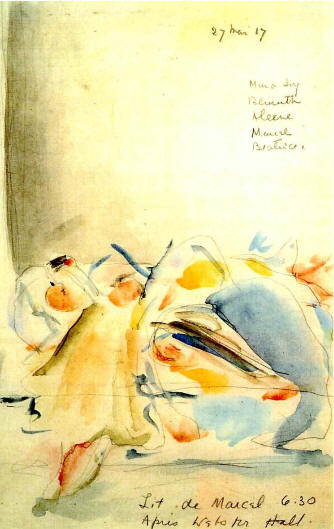
Lit de Marcel [Marcel's Bed] (1917): watercolor (Beatrice Wood,
Marcel Duchamp, Charles Demuth, Aileen Dresser, and Mina Loy)
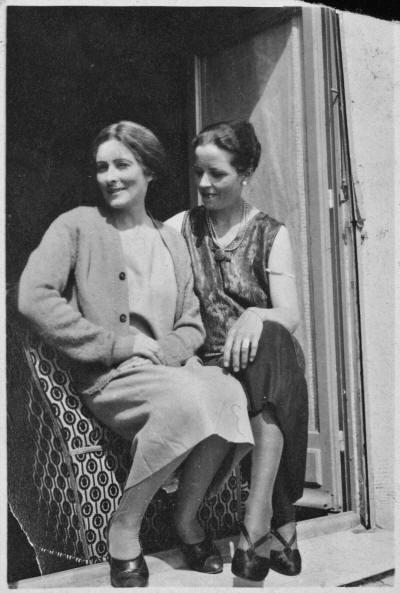
Mina Loy and Djuna Barnes
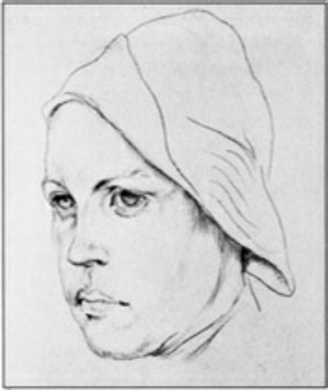
Carl Van Vechten by Mina Loy, 1913
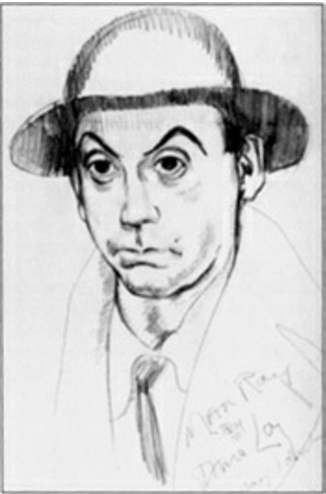
Man Ray by Mina Loy
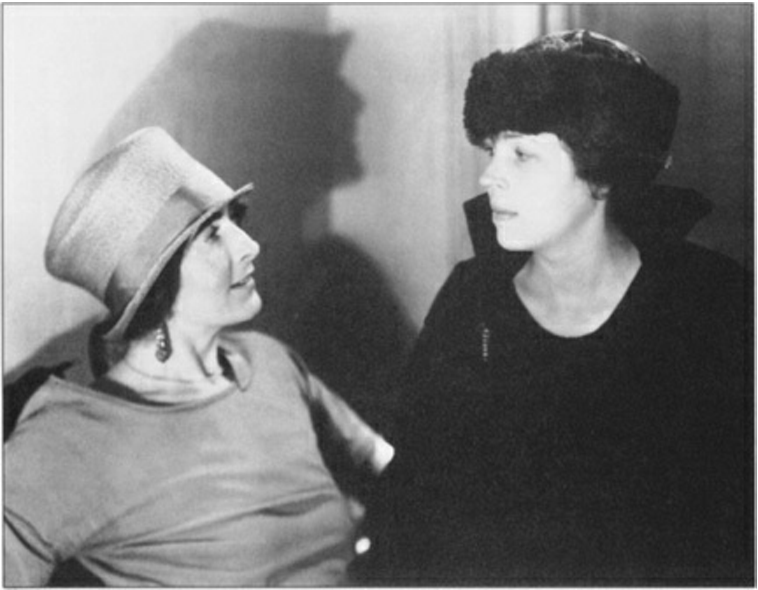
Mina Loy and Djuna Barnes by Man Ray
Villa dell'Ombrellino
In 1900 Loy attended the Munich Künstlerinnenverein, or the Society of Female Artists' School, which was connected with the fine art school of Munich University, it was there that she claimed she learned draughtsmanship.[13]
Upon returning to the stifling environment of her family home in London, after the relative freedom she found in Munich, Loy suffered from "headaches, respiratory problems, and generalized weakness" which was then diagnosed as neurasthenia – "a catch-all term for a variety of psychosomatic complaints suffered by artistic or intellectual women and a few sensitive men" during that time period.[14]
Around the age of eighteen, Loy convinced her parents to allow her to continue her education in Paris with a chaperone – a woman called Mrs Knight.[15] After much persuasion, she was allowed to move to Montparnasse, which in 1902 had not yet been urbanised, and attend the Académie Colarossi as an art student.[16] Unlike the segregated classes at the Munich Künstlerinnenverein, these art classes were mixed. It was here, through an English friend of a similar social standing named Madeline Boles, that Loy first came into contact with the English painter Stephen Haweis who Loy later described as enacting the "parasitic drawing-out of one's vitality to recharge, as it were, his own deficient battery of life."[17] According to Burke's biography, Haweis was unpopular with his fellow students, being considered a "poseur," and Boles in particular took him under her wing.[17] Haweis, whose father was the well-known Reverend H.R. Haweis and his mother Mary Eliza Haweis a writer who wrote, amongst other things, Chaucer for Children: A Golden Key, was an aesthete of sorts and "despite being very short[,] he managed to condescend to his listeners from a height."[17] He began to exert himself over Loy, recognising her beauty and desirability, and played the role of the misunderstood eccentric which led Loy to feel guilty for disliking him and distrusting him as he borrowed more and more money from her without paying her back. Later she would reflect that Haweis loomed over her and she became, in Loy's own words, "as sullenly involved as with my mother's sadistic hysterics."[18] One night he convinced her to stay over and, in what she would later describe as a state of hypnosis, she was seduced by him. Waking up next morning in his bed, semi-naked, Loy was horrified and repulsed.
A few months after this, she realised that she was pregnant, something which terrified her as it bound her, as she later described, even closer to "the being on earth whom she would have least chosen."[19] Being only twenty-one, she faced a difficult situation and, fearing rejection from her family and disinheritance, which would leave her penniless, she sought her parents' approval to marry Haweis, which they agreed to due to his respectable social status as the son of a preacher. Reflecting on this in later life, and how her upbringing influenced her in the decisions she made, Loy remarked that "If anyone I disliked insisted upon my doing anything I was averse to I would automatically comply, so systematically had they obfuscated my instinct of self-preservation."[20]
Relocating to Paris, Haweis and Loy married there, in the 14th Arrondissement, on 13 December 1903 – Loy was twenty-one, and four months pregnant.[21][22] Initially they agreed that it would be just a marriage of convenience, but Stephen became quickly more possessive and demanding. Instead of taking her husband's name, after their marriage she changed her last name from "Lowy" to "Loy."[23] Becoming Modern: The Life of Mina Loy (1996) biographer Carolyn Burke notes that "[t]he anagrammatic shifts of Lowy into Loy and later Lloyd symbolize her attempts to resolve personal crises and chooses to refer to Loy as Mina – the name that stayed fixed as her surname varied."[24]
Starting in 1903 until 1904, after meeting the Englishman Henry Coles, Haweis began selling photographies d'art, or fine art photography pieces, influenced by Art Nouveau style. The most notable commission of this time was the photographing of the recent works of Auguste Rodin which came about after Haweis met with Rodin himself.[25] At that time, Loy was Haweis's favourite subject to photograph; this is something which Loy never commented on.[25] As Haweis gained more contacts and work, Loy became increasingly isolated and heavily pregnant.
Loy's first child, Oda, was born on 27 May 1903. The labour was hard, as recalled in the early poem "Parturition" (first published in The Trend 8:1, October 1914).[26]
Two days after her first birthday, Oda died of meningitis and Loy was left completely bereft with grief over the loss.[24] A day or so after Oda's death Loy reportedly painted a (now lost) tempera painting The Wooden Mother in which she depicted two mothers with their children, one being a "foolish-looking mother holding her baby, whose small fingers are raised in an impotent blessing over the other anguished mother who, on her knees, curses them both with great, upraised, clenched fists, and her own baby sprawling dead with little arms and legs outstretched lifeless."[27]
Loy decided to enter the Salon d'Automne under the name "Mina Loy" (having dropped the "w" in Lowy) in 1905. That autumn she exhibited six watercolours and the following spring she exhibited two watercolours at the Salon des Beaux-Art of 1906.[28]
After this positive reception Loy was asked to become a sociétaire of the drawing category, which meant that her work could be exhibited without having to pass through a selection committee. This was a "vote of confidence" which, as biographer Burke recognises, "was an exceptional mark of recognition for an unknown Englishwoman of twenty-three".[30]
By 1906 Loy and Haweis had agreed to live separately. During this period of separation Loy was treated by a French doctor named Henry Joël le Savoureux for neurasthenia, which had worsened with the death of Oda and living with Haweis, and the pair embarked on an affair which would end with her becoming pregnant. This made Haweis jealous and precipitated their move to Florence, where there were fewer people who knew them.[31]
Loy and Haweis moved into a villino located in the countryside outside of the city, finding themselves in a large expatriate community.
On 20 July 1907, Loy gave birth to Joella Sinara. A few months before Joella's first birthday Loy was pregnant again, this time with the child of Haweis, and she was to give birth to a son named John Stephen Giles Musgrove Haweis on 1 February 1909.[32]
Joella was late learning to walk, which was later diagnosed as a type of infantile paralysis which caused her muscles to atrophy. Dreading that Joella's condition might be like the meningitis that killed Oda, Loy sought medical and spiritual support. This was one of her earliest, critical encounters with Christian Science as she sought out a practitioner named Mrs. Morrison, who prescribed a treatment and told Loy to feed Joella beef broth and donkey's milk. After this succeeded in improving Joella's health, Loy began to attend church regularly.[33]
Loy and Haweis then moved to a second house, this time on the Costa in Oltr'arno. Here, as it was cheaper than villadom, they were able to afford a three-storey home with the money provided by Loy's father for a home but, despite this, as was customary at the time, the deed was put in Haweis' name.[33] The family had a nurse, Giulia, who helped raise the children and would later spend years being the children's sole support, and her sister Estere, who was the family cook. Once the children were toddlers, Loy spent increasingly less time with them and they were often cared for in the cooler climate of Forte de Marmi. Burke speculates that this may have been a reaction to the overbearing intrusion of her own mother which led her to withdraw.[33]
Loy frequented the social gatherings held by Mabel Dodge and it was here that she met Gertrude Stein and her brother Leo Stein. Loy was drawn to Gertrude and even got the opportunity to dine with her, Dodge, and Andre Gide.[34] Gertrude would later recall that Loy, as well as Haweis, were amongst the few at that time who expressed serious interest in her work (she had not yet been widely recognised for her literary achievement). However, Gertrude recalls an incident where Haweis begged her to add two commas in exchange for a painting, which she did, but then later removed them; contrarily, Gertrude noted that 'Mina Loy equally interested was able to understand without the commas. She has always been able to understand.'[35] Loy would attend services at the Florentine Christian Science church with the Steins around this period. Whilst the Steins' interest in the religion would not last, Loy became a lifelong convert – albeit idiosyncratic.
After Mabel Dodge moved to America, she introduced Mina Loy to the bohemian New Yorkers who made up her entourage whenever she briefly took up residence again in Florence: John Reed, Mabel’s lover for a time; the critic and dandy Carl Van Vechten; the writer Hutchins Hapgood; and many others. For all her airs and affectations, her duplicity and deceptions, Mabel was “a great salvation,” Mina said. Mina nicknamed her Moose, and Mabel became Giles’s godmother.
In 1914, while living in an expatriate community in Florence, Italy, Loy wrote her Feminist Manifesto.[37] A galvanising polemic against the subordinate position of women in society, the short text remained unpublished in Loy's lifetime. She had been sending a steady stream of new poems to Carl Van Vechten too, hoping that American readers would be more open-minded than the English. “I don’t believe men in England have got any of the new consciousness about things. . . .,” she wrote him in a letter. “I believe we’ll get more ‘wholesome sex’ in American art.” Van Vechten had already placed several dissonant poems from the thirty-four-piece sequence she had titled Love Songs in a new avant-garde literary magazine called Others, edited by Alfred Kreymborg.
Disillusioned with the macho elements in Futurism (Loy had a relationship with both Filippo Marinetti and Giovanni Papini) and its move towards Fascism, as well as desiring a divorce from her husband Stephen Haweis, Loy left her children with a nurse and moved to New York in 1916, where she began acting with the Provincetown Players. She was a key figure in the group that formed around Others magazine, which also included Man Ray, William Carlos Williams, who was "furtively in love" with her, Marcel Duchamp, the wealthy art patrons Walter and Louise Arensberg, and Marianne Moore.[38] Loy soon became a leading member of the Greenwich Village bohemian circuit. In was called the Provincetown Players, Loy played the main role in Kreymbourg's play Lima Beans, an experimental production.[39] While in New York, she worked in a lamp-shade studio, as well as acting in the Provincetown Theater. Here she returned to her old Greenwich Village life, perusing theatre or mixing with her fellow writers. During this period, some of Loy's poems ended up in small magazines such as Little Review and Dial.[1] She would mingle and develop friendships with the likes of Ezra Pound, Dadaist Tristan Tzara, and Jane Heap. Tzara in most accounts in 1916 was involved in founding Zurich Dada; Loy did contribute writing to Marcel Duchamp's two editions of the journal The Blind Man.
Elsa von Freytag-Loringhoven overlapped with Loy in attendance at salons such as the Louise Arensberg apartment. Although the two women were closer to famous men of the movement than to each other, both proved key figures for the Dada movement; at the height of the Ulysses obscenity trial, the editors of The Little Review planned an issue featuring Loy and the Baroness “as a defense of Art.” The women were photographed together by Man Ray for this issue.
In Beatrice Wood's memoir, I Shock Myself, the actress cum artist recounts the events that took place after the infamous Blindman's Ball on May 25, 1917. According to Wood, several attendees returned to Walter and Louise Arensbergs' apartment, en route to Marcel Duchamp's one-room studio, located above their salon at the 33 West 67th street building, which had by 1915 become a key center of New York dada. Wood and Duchamp, together with Charles Demuth, Aileen Dresser, and Mina Loy, proceeded to wedge themselves into the narrow confines of the artist's single bed. Always the "host," remarked Wood, "Marcel . . . took the least space and squeezed himself tight against the wall, while I tried to stretch out in the two inches left between him and the wall, an opportunity of discomfort that took me to heaven because I was so close to him." In the days that followed, Wood produced a small 8 ¾ x 5 ¾" watercolor sketch commemorating the intimate encounter, which she titled Marcel's Bed (Lit de Marcel) (1917).
In New York, Loy met the "poet-boxer" Arthur Cravan, a self-styled Dadaist who was a nephew of Oscar Wilde's wife, Constance Lloyd. Born Fabien Lloyd in 1887, Cravan was a provocateur of legendary proportions, a “fugitive, forger and master of disguise,” who had evaded military conscription for years. Tall and ruggedly handsome, with an appetite for scandal almost as insatiable as his taste for drink, he claimed, among his various personae, to be Oscar Wilde’s nephew. He was already a notorious figure in European circles by the time he reached New York. In Paris he’d been a fixture of the avant-garde, sighted at balls with the painter Robert Delaunay, dancing the tango in wildly colored costumes, or in a black shirt with cutouts through which one could see obscenities penned in red on his chest. In Berlin he had paraded through the streets carrying four prostitutes on his shoulders. The first time Cravan appeared at the Arensbergs’, Juliette Gleizes pronounced his blond, Anglo-Saxon beauty “the sort common among lifeguards” and judged him extremely brutish under the influence of alcohol. Mina felt much the same. He looked like a “half-imbecile savage,” she wrote. As spring progressed, she found herself drifting toward this peculiar, belligerent man, despite her initial hostility. Often she and Cravan buried themselves in the same deep armchair at the Arensbergs, sharing a book. One night, as they were leaving, he said, “You had better come and live with me in a taxicab. . . . We can keep a cat.”
Cravan fled to Mexico to avoid the draft; when Loy's divorce was final she followed him, and they married in Mexico City in 1918.[23] Here they lived in poverty and years later, Loy would write of their destitution. When she found out that she was pregnant, she travelled on a hospital ship to Buenos Aires, "where she intended to wait for Cravan, but Cravan never appeared, nor was he ever seen again".[23] Reportedly, "Cravan disappeared while testing a boat he planned to escape in. He was presumed drowned, but reported sightings continued to haunt Loy for the rest of her life."[1] Cravan was lost at sea without trace;[40] although some mistakenly claim that his body was found later in the desert (postmortem, his life acquired even more epic proportions and dozens stories proliferated).[41] The tale of Cravan's disappearance is strongly anecdotal, as recounted by Loy's biographer, Carolyn Burke.
After Cravan's death/disappearance, Loy traveled back to England, where she gave birth to her daughter, Fabianne, in April 1919.[1] Loy would return to Florence and her other children. However, she moved to New York.[45] In a chapter of her largely unpublished memoir entitled Colossus, Loy writes about her relationship with Cravan, who was introduced to her as "the prizefighter who writes poetry."[42] Irene Gammel argues that their relationship was "located at the heart of avant-garde activities [which included boxing and poetry]."[43] Loy draws on the language of boxing throughout her memoir to define the terms of her relationship with Cravan.[44]
Appearing to be somewhat mystified by the new kinds of poetry being produced by Loy and her ilk, Pound remarked in a March 1918 piece for Little Review, "In the verse of Marianne Moore I detect traces of emotion; in that of Mina Loy I detect no emotion whatsoever", seeing them both as demonstrating logopoeia, the writing of poetry without caring for its music or imagism. Instead, in their poetry, they performed "a dance of the intelligence among words and ideas and modification of ideas and characters." Pound concludes, "The point of my praise, for I intend this as praise...is that without any pretences and without clamours about nationality, these girls have written a distinctly national product, they have written something which would not have come out of any other country, and (while I have before now seen a great deal of rubbish by both of them) they are, as selected by Mr. Kreymborg, interesting and readable (by me...)."[46]
In his autobiographical novel about avant-garde New York, Post-Adolescence, Robert McAlmon includes a telling vignette recalling how Djuna Barnes and Mina Loy reconnected after the war. The two women, who appear under pseudonyms, immediately fall into conversation, commiserating over each other’s travails: for the Djuna character, multiple abortions and the burden of having had to support three brothers, a husband, and all her lovers; for the Mina character, her bereavement over the disappearance of her husband. Man Ray, also noting the affinity, asked if he might photograph the two women together. “They were stunning subjects,” he remembered of the session. Years later, Djuna would write to Mina: “I often think of the jolly times we had, do you remember, when there was a fire & I read aloud and you did cross-word puzzles?” Mina, for her part, would note in her diaries Djuna’s loyalty as a friend, recalling also her “supreme elegance of clothing.”
In 1921 Mina Loy was still unable to let Cravan go and ashamed by her inability to do so. A man had an easier time than a woman, she noted in her journal. In the end a woman is defeated by life, “whether she cares about others’ opinions or not.” “My health is very smashed up & I don’t know what will be next,” she wrote Mabel in Taos, New Mexico, where she was now living with her new husband, Tony Luhan. Too miserable to continue work on her novel and worried now that she was beginning to crack, Mina left for a “rest cure” at the Rose Valley sanatorium in Pennsylvania, where she remained for the next two months. Desperate, she wrote Mabel asking for help. She wanted to start a little restaurant in Paris, she said. She felt that there she could make enough to support the children. Mina’s pleading letter to Mabel requesting money seemed to have been met, at least in part. A few months later, sometime in 1921, Mina was en route to Paris and soon after to Florence, where she finally joined her two daughters, Joella, now fifteen, and Fabienne, her daughter by Cravan, now three. Haweis had moved with Giles to the Caribbean".[1] Loy brought her daughters to Berlin in order to enrol her daughter in dance school, but left them once more because she was drawn back to Paris by the art and literature scene.[1]
Berenice Abbott and Mina Loy crossed paths in 1922 on Abbott’s visits to Berlin with other Paris-based ex-pats. Later in 1948, from her nearby studio in Greenwich Village Abbott visited Loy at 5 Stanton Street to photograph the scenes Loy constructed from discarded items in homage to her homeless Bowery neighbors. She asked Abbott to photograph the fragile series, and Abbott in turn suggested an exhibition. Abbot believed Loy made the series “to demonstrate her belief that vision was itself a form of salvation”, although Loy doubted anyone unfamiliar with the Bowery would understand it.
In 1923, Loy returned to Paris. Her first volume of poetry, Lunar Baedecker, a collection of thirty-one poems,[1] was published this year and was mistakenly printed with the spelling error "Baedecker" rather than the intended "Baedeker".[47] In Paris Mina hooked up with an old friend, the writer-playboy Laurence Vail (also one of Djuna Barnes’ former lovers) and Vail’s wealthy new wife, Peggy Guggenheim. Peggy agreed to fund Mina in a lampshade business, which for a time thrived, gradually expanding to include glass novelties, paper cut-outs, and painted flower arrangements. But by 1928, the two women had quarreled, bringing the business to a close. Djuna, who lived in Mina’s building in Paris and was now her closest friend, decided to return to New York soon after, leaving Mina feeling increasingly stranded.
Despite these successes in her literary career, the need to provide for her family led her to the manufacture and design of bespoke lampshades and found financial backing from Peggy Guggenheim to open up a shop. Loy also resumed old friendships with Djuna Barnes and Gertrude Stein. In the early 1930s, while still living in Paris, Loy began writing Insel, a künstlerromannthat fictionalises her friendship with German surrealist painterthat fictionalises her friendship with German surrealist painter Richard Oelze, a friendship begun in part because Loy was the Paris agent for her son-in-law, a friendship begun in part because Loy was the Paris agent for her son-in-law Julien Levy's New York gallery.'s New York gallery.
In 1936, Loy returned to New York and lived for a time with her daughter in Manhattan. She moved to the. She moved to the Bowery, where she found inspiration for poems and, where she found inspiration for poems and found object assemblage art in the destitute people she encountered. There she lived for the next seventeen years alone, moving every few months to a new communal rooming house. At first Mina saw a few old friends, but as the years went on, she became progressively more antisocial. And money became a problem. Finally, she refused to see anyone. “Mina is in the last stages of depression and won’t let me come see her,” Djuna Barnes wrote to Robert McAlmon in 1940.
On 15 April 1946, she became a naturalised citizen of the United States under the name "Gertrude Mina Lloyd", resident at 302 East 66 Street in New York City.[48] Her second and last book, Lunar Baedeker & Time Tables, appeared in 1958. She exhibited her found object art constructions in New York in 1951 and at the Bodley Gallery in 1959, organized by Marcel Duchamp. In 1953, Loy moved to Aspen, Colorado, where her daughters Joella and Jemima were already living; Joella, who had been married to the art dealer of Surrealism in New York, Julien Levy, next married the Bauhaus artist and typographer Herbert Bayer. Towards the end of her life, Loy became rather shut-off from the world and failed to publish a collection of poems (some were published after her death) and a never-finished biography of dancer Isadora Duncan.[49]
Loy's poetry was published in several magazines before being published in book form. The magazines that she was featured in include Camera Work, Trend, Rogue, Little Review, and Dial.[1] Loy had two volumes of her poetry published in her lifetime: The Lunar Baedeker (1923) and The Lunar Baedeker & Time-tables (1958). The Lunar Baedeker included her most famous work, "Love Songs", in a shortened version.[1] It also included four poems included in Others in 1915, but their sexual explicitness had provoked a violent reaction, which made it difficult to publish the rest.[1] Posthumously, two updated volumes of her poetry were released, The Last Lunar Baedeker (1985) and The Lost Lunar Baedeker (1997), both edited by Roger L. Conover. Songs to Joannes is in The Lost Lunar Baedeker.[50]
Her only novel, Insel, was published posthumously in 1991. It is about the relationship between a German artist, Insel, and an art dealer, Mrs. Jones. Some critics have suggested that the novel is based on Loy's relationship with Richard Oelze. However, Sandeep Parmar has said that it is actually about Loy's relationship with her creative self.[51]
Loy had four children; her children by Haweis were Oda Janet Haweis (1903–1904), Joella Synara Haweis Levy Bayer (1907–2004) and John Giles Stephen Musgrove Haweis (1909–1923). Her only child with Cravan was Jemima Fabienne Cravan Benedict (1919–1997).[41] Both Oda and John Giles passed away prematurely, Oda at one-years-old, and John Giles at fourteen.
Oda's birth took place on 27 May 1903, the labour of which is intimately related in the early poem "Parturition" (first published in The Trend 8:1, October 1914). One year later, two days after her first birthday, Oda died of meningitis and Loy was left completely bereft with grief over the loss.[24]
Giles, whose father Stephen Haweis picked him up from Florence in Loy's absence and took Giles without her consent to the Caribbean, died of a rare cancerous growth at the age of fourteen having never been reunited with his mother.[24] According to Loy biographer Burke, the loss of Giles added to her loss of Cravan caused her to have mental health struggles and her daughter Joella often had to care for her and prevent her from self-harming.[24]
She continued to write and work on her assemblages until her death at the age of 83, on 25 September 1966 from pneumonia in Aspen, Colorado.[1] Loy is buried in Aspen Grove Cemetery.[52]
My published books: